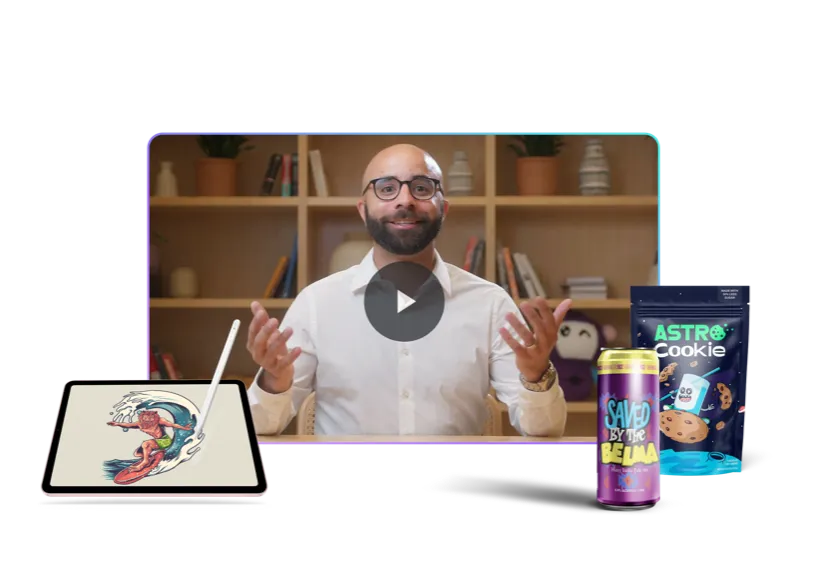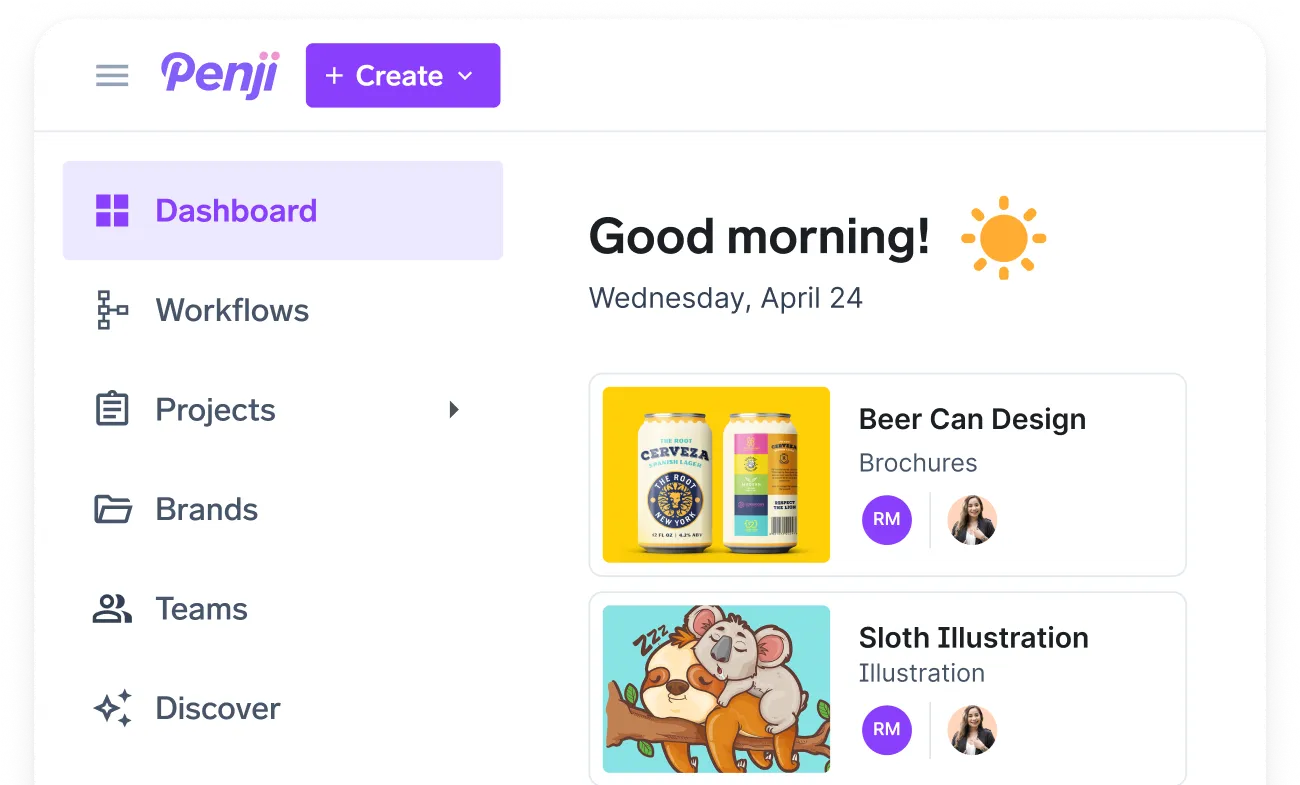![[Fully Managed] Holly Medwid from Monarch Social Media Ep. 136](https://penji.co/wp-content/uploads/2025/07/BLOG-IMAGE-Holy-Medwid-1.jpg)
Introduction
Shannon Donnelly (SD): Alrighty. Hello, everyone, and welcome to the Fully Managed Podcast, the podcast where we discuss marketing and business tips to help assist you on your business journey. I’m your host, Shannon, Penji’s Partnership Coordinator, and I’m joined here today with a very special guest, Holly Medwid from Monarch Social Media. Thank you so much for coming on with me today.
Holly Medwid (HM): Thank you for having me. I really appreciate that.
SD: Could you just start by telling us a little bit about yourself? You can share a fun fact, your work, and how you got to this point in your career.
HM: Fun fact. I am a plant mom of thirty-seven plants. When I have some off time from social media, I like to do things that are not related to the screen. How I got into my work, it’s a weird story. I was going to school to become a writer. I wanted to become a novelist, and to practice the craft of writing during university, I had a blog. This is going back fourteen, fifteen years ago now. It was before “influencer” was a job. To drive traffic to the blog, because it wasn’t enough just to write it, I wanted feedback. I used social media to make that happen. What ended up happening was a local business took notice of what I was able to do. I was being invited to events and campaigns and launches to cover whatever they were promoting. That’s when thetronopath.com took notice and said to me, can you do this for us? We’ll pay you.
So it was really at the beginning of social media as an industry. I did a short internship with a little boutique agency, took this position. At the time, I was working about three jobs to put myself through school. I was sitting in class writing tweets for this paid position, and my professor goes, Holly, if you don’t pay attention in class, you’re never going to get paid as a writer. And I just looked at him and said, I am being paid as a writer. It was this massive light bulb moment. I realized I didn’t need the institution and to spend all this money and work around the clock just to pay for this in order to be paid as a writer. I can do this on my own. And that is how my career started. I quit university after that semester and it’s been continuous growth ever since.
SD: I love hearing that. I also worked three jobs in college. So one, I love hearing that because it just reminds me of me. And it’s also really hard. Personally, I didn’t use my degree. I thought it was helpful, and I really like school, but I acknowledge that it’s not for everyone. I think they could very easily modify it to be for more people, but they don’t. I completely understand how much of a struggle it is to maintain doing studies, pay for it, and then also pay for everything else that you have to pay for during that time. But it’s incredible that you found out what you wanted to do through that process.
HM: Yeah, I was very lucky in my career, I would say.
Founding Monarch Social Media
SD: So what was the inspiration for starting Monarch Social Media? You kind of talked about the jobs that you had, but what made this become?
HM: It was kind of a series of events, to be honest. I took this job with this company, ended up having businesses say, hey, can you do this for us? So I started freelancing, and then I had a hotel company say, hey, can you come in in-house and do this for seven hotels? I became the marketing manager for those seven hotels in downtown Toronto, and then became head of growth for a startup. I always had my finger on the pulse of social media, because that was a really important part of the job.
In the past six years before starting this agency, a lot of my skillset was toward other marketing disciplines to learn full digital strategy. Over the pandemic, two things happened. One, my father bought a wild rice processing plant and wanted to bring the product to market. As a digital marketer, I wanted to help out the family company there. The other one was when everything locked down and lockdowns were quite severe in Canada, all these businesses had to physically close and move operations online. That was a really hard transition. So in my off hours, I was giving away consulting advice for free. Because I track my time like any agency owner does, I realized I gave away over thirty thousand dollars in consulting for free. I had a company say, hey, can you manage their social media? I always said if I was ever to go back into just the business of social media, it would be from the agency perspective and to create an agency model that is very ethical toward the people that work in that industry.
Preventing Burnout in Social Media Work
SD: In social media, all of us burn out. It’s a really demanding job. People think it’s really easy, but it’s not. We lose really good talent from this industry because they’re burnt out or the expectations are completely unrealistic. Sorry, I didn’t mean to interrupt you.
HM: No, I completely agree with that.
SD: That actually brings me to my next question. Being so heavily involved in social media, how do you provide a healthy balance for yourself when being so consumed in it? Do you have any systems in place?
HM: Let me tell you about my systems. This is actually something I’m really passionate about because, again, in my industry, especially days like today, where it’s the US election and social media is crazy, it’s really mentally draining. When you’re in this industry, you see the good, the bad and the ugly—and a lot of it is bad and ugly. Not to mention just the expectation of the job and having to switch between a communications brain, a creative brain and an analytical brain.
At the agency, we’ve separated those roles. Our communication team only talks to people online—that’s their whole job, all day long. The creative team curates and creates content for platforms. Strategy and analytics look at the data, adjust strategy, and report to the client. That’s how the ecosystem works.
As a social media professional, you also need routines in your life. I don’t start my morning by picking up my phone. I start with a cup of coffee and what I call a junk book—like a binge reading book. Give me the nerdiest book possible. That’s how I spend my start to the day because it’s enjoyable. Cold exposure is a big one for me. I do ice baths every day.
SD: Not insane at all. I actually used to do ice baths a lot when I was a teenager. I was very stressed.
HM: You know the benefit of it.
SD: Honestly, I think at the time I didn’t. But I do now. It releases a lot of stress. I can recommend it to anyone dealing with anxiety or stress. It gives you a rush of endorphins and really grounds you.
HM: Work hours are work hours. Boundaries are really important. Social media doesn’t sleep, but we do. We’re accessible Monday to Friday, nine to five. All accounts are monitored evenings and weekends. We have an emergency request form—if there’s a troll attack, natural disaster, or hacking—it notifies someone on the team immediately.
Also, hobbies outside of the screen are essential. People on my team are likely upwards of eight to fourteen hours a day on their phones. You need hobbies with nothing to do with phones. For me: cooking, plants, crocheting, yoga, Pilates, ice baths, walking my dog. These things keep my mental health in check.
SD: Thank you. I think this advice is helpful to everyone, not just social media marketers. Social media is difficult to manage. I really like your emergency line system and the boundaries. And the way you separated job categories—communications, creative, and strategy—is brilliant.
HM: That comes from doing this job for thirteen years. New social media managers often get caught in the trap of Saturday night client messages. That’s not a healthy work environment. Why should social media be an exception?
SD: Exactly. Clients need to learn boundaries, too. Respect is a part of a professional relationship. Emergencies happen, but balance is important.
HM: Most clients respect that. But starting out, you’re often taking smaller clients where your thousand-dollar package means everything to them. You feel like you must always keep them happy, but it must be within reason.
SD: Definitely. And when you’re starting an agency, sometimes you have to devote more time to build it. But you still need to respect yourself and avoid overworking.
HM: Otherwise, you burn out. I’ve burnt out many times. It’s hard to recover and bad for your health.
SD: One hundred percent. After working three jobs in college, I had no motivation to be in the workforce. Ironic, since that’s what school is supposed to prepare you for. But now, with the digital world, all this info is online and often free. You can get certified through platform-specific courses.
HM: Exactly. Sure, school teaches marketing principles, but you can learn this on your own. The most important skill in social is self-education.
SD: I agree. HubSpot’s free certifications are wonderful. People recognize them. Plus, they have standards—you can verify what someone learned. Unlike college degrees, which vary.
HM: And college curriculums can’t keep up with platform changes.
SD: Exactly. My political science classes were mostly outdated. Research takes too long. It’s great to learn things in real time, especially in a fast-changing space like marketing.
Navigating Rapid Changes in Marketing
HM: Oh, marketing is… You can’t—something can change drastically tomorrow.
SD: Yeah.
HM: That’s true because not only do the platforms change—the features, the software, the way the algorithms function—but the consumer patterns change. I always love seeing traditional marketing try to copy a social media trend because they can’t do it in a timely way. I’ll give you an example. In Toronto, which is where I’m physically located, the demure trend—if I say the demure trend, you know what I’m talking about. I was driving down the highway the other day and one of our LED signs says, “Safe driving is very demure, very mindful.” And I’m going, A) wrong way to use a social media trend when people are driving—that is very distracting. And B) you’re about two months too late to jump on.
SD: Yes. I think that’s such a difficult thing, especially when a company is heavily involved in social media but they’re not pushing things out at a rapid pace. Even we have had that experience in our own company in the past. We have a good idea for a video, but the editing just takes a little longer than we originally wanted it to. And then we just have to scrap it because by the time it comes out, it’s not relevant anymore and no one’s going to watch it. It’s a tricky thing to navigate.
SD: And speaking of, I was actually wondering—do you find any social media platforms more difficult to navigate for campaigns than others?
HM: Depends on the business, depends on the goals, depends on the budget, the assets required. So you’d have to give me a little bit more of a… because every platform has its complexities. I’ve had amazing success on every single platform, but the strategies have always been different. The client has always been different, and the assets available, the budget available, has always been different. So it really depends. What are we talking—B2B, B2C, e-commerce?
SD: Let’s do e-commerce.
HM: E-commerce, okay. Black Friday is a great time. I would say the key thing right now with e-commerce is to actually leverage something called the UGC strategy. That’s going to get rid of about fifty percent of the issues you’re going to face with content creation because it rewards more authentic positioning of your product or service by relying on other creators to put it in their own words—which is very indicative of the style of content needed for TikTok to go viral. If you use that platform, you’ll probably notice most creators just pull up their phone and start recording. It’s not, “Let me set the lighting.” Like, Instagram is very, “Let me position this perfectly and then record,” where TikTok is messy.
HM: It can be a challenge to manage that platform if you don’t have enough content. The way to deal with that as an e-commerce brand is to use UGC strategy because it’s going to perform better than any brand-created content anyway. And also, be willing to think outside the box when it comes to content to make it work. So if your CEO wants to be involved in the strategy, do it from the perspective of humanizing that CEO and showing their personality. Don’t do it from the perspective of “Let’s script this whole video, make it perfect, and then post it.” It falls flat. A perfect example of that is Gap. I haven’t looked at them in a while, but I was expecting millions of views—and some of their TikToks had like ten thousand. Which is still high, but not high for Gap. And the reason why is because they’re using studio-shot content, not UGC content.
Platform Preferences and Meta Challenges
HM: As long as your expectations and efforts are aligned with what’s realistic with those platforms, it’s fine. I would say my least favorite platform personally is anything Meta. It’s messy. Oh my goodness, is it messy. I don’t mind Threads as an engagement practice for certain strategies, and there’s a lot of value if you’re marketing a product or service that’s focused on the Boomer demographic. Facebook is beautiful if you combine the organic and paid strategy. But nine times out of ten, when we start a client relationship, I am having to do so much work to organize their Meta assets and make sure everything is under their ownership and centralized in the proper way. So if I had to pick one platform I would axe—it would be Meta. Which I know we can’t do, because it’s the biggest one.
SD: Yeah, no, but I definitely can resonate with that. I also think what you said about TikTok is really interesting because I was just thinking about this the other day with Gap—which is so funny. I got an Instagram ad for Gap, and I thought that was interesting because the last time I went to Gap, I was maybe thirteen. I was looking through it and thought, “Oh wow, they’re really good with the trending clothing right now.” Because back then, they just had basic clothing—like one-color shirts and jeans. I never noticed anything unique about them, and I really like unique clothing. But I was looking at their clothes now and thought, “Wow, they’re doing really well with fashion trends.” But I wondered why this is the first time I’ve seen an ad for them in so long if they’ve been doing this.
SD: That was something I thought—maybe they’re just not very good at social media engagement. Because this was just an ad. It wasn’t anything unique. It was probably a paid advertisement on Instagram and nothing more. Meanwhile, I see so many other newer brands doing social media so much better than them. And it’s interesting, because Gap has been around for so long. If they adapted better, I think they’d be doing so much more. Because the clothing is there—they are updated on trends—but their social media is definitely lacking.
HM: That comes down to a phenomenon that happens a lot in the digital services industry. And this is going to make me so unpopular, but it’s okay—I never liked the popularity contest. A lot of times, brands think, “We need to go with the big agency to have our social media done.” And big agencies are wonderful for a lot of things. They can absolutely get results. A lot of times, they’re doing all of the services. And this job—social media—because it’s relatively newer in the world of digital marketing services, I mean, it’s like twenty years old already, but as a job, people are still going, “Oh, maybe I should invest in social.”
HM: That job is generally put on a younger team member who’s either in an internship or brand new to their career. And then the entire job is put on that person. They’re fighting against creative directors, upper management, and no one’s listening to those younger voices who are active on the platforms and actually know how to make things trend. No one’s listening to their feedback to say, “You know what? Maybe we don’t know. Maybe we need to invest more.” A lot of it comes down to investing more—and investing in the right talent for social media.
HM: I’m a big believer that if you are a jack-of-all-trades, master-of-none type agency, you cannot do social media justice. The reason my agency only does social media is because that’s the only digital service I want my team focused on. It takes a lot to make it work on behalf of a brand or business. If I start distracting them with, “Now build an SEO strategy, build a website, do this,” it’s going to dilute our efforts.
HM: So I think a lot of brands fall victim to going with a bigger agency because they think that will get them results, when in fact, many of those agencies don’t have their social departments set up in a realistic way.
SD: No, I completely agree with you. When I see a really good marketing campaign, I like to look up who did it. Especially if it’s a very unique campaign for a big brand—it usually turns out to be an agency I’ve never heard of, and it’s significantly smaller. Those are the best campaigns. Because marketing is a gamble, and smaller agencies aren’t necessarily less successful—they’re just more specialized. Adding more people wouldn’t necessarily be more efficient. Sometimes it works in their favor.
SD: I think a lot of big brands don’t want to risk working with a smaller agency because they see it as risky. But I don’t believe that. I see a lot of great work come from smaller ones.
HM: Thank you. Thanks for noticing that. You’re absolutely right. The thing we all wish bigger brands understood is—you have the agency that handles your branding. You have brand guidelines, messaging, FAQs, and all the assets we need to do our job well. Lean and mean social media teams are the ones that get results because it’s all we focus on. Is it a risk? Yeah, maybe. But it’s more of a risk to let your competitor run with a unique strategy.
HM: I’m a middle millennial. The benefit of our generation is we grew up with the internet—we literally grew up with it. Especially social platforms. We started with MySpace, MSN Messenger, blogs, zines. I remember when Facebook first came out—I was in high school. One of my older friends was at one of the early universities that got it, so I got invited early. So we saw the evolution. And we’re not just app-based—we’re desktop-based. We can navigate both fluently.
HM: It’s not a knock on any other age group. But we really understand this medium and how to make it work. And I have to give it to Gen Z. They come to the table with so much creativity. They scare me sometimes, but they’re incredible. I’ll ask one of our team members, “Catherine, what does this mean?” and she’ll break it down. At the beginning of summer, she had to explain “brat summer” to me. And now I catch myself dropping a “Gucci” when someone asks how something’s going—and I think, “No, I don’t say that!”
HM: So they bring a lot of excitement and creativity to strategies. You just have to know how to work with Gen Z. And I think that’s probably why smaller agencies—who tend to be younger—have a perspective you just can’t touch.
The Power of Small Agencies and the Craftmix Example
SD: I definitely agree with that. Seeing the campaigns that smaller agencies create is so incredible. I love when I see a unique campaign for a large corporation that turns out to be done by a small agency. People don’t usually look up who made a marketing campaign—they enjoy it, buy the product, and move on. But it’s fun to dig into who created it, because it’s often someone unexpected.
HM: Corporations fall into the trap of sticking so tightly to their brand identity that they don’t want to go out of the box. The best campaigns do just that—break the mold. Big agencies often cater so much to brand identity that even they stay inside the box. Especially with older brands like Coca-Cola. They rarely do anything wild because they don’t have to—people have been loyal to them forever.
HM: Let me give you an example of a smaller creator who ran one of the best campaigns I’ve seen: Craftmix. Sometimes a brand has a negative moment, but this was the best crisis management response I’ve seen in a long time. Study the Craftmix saga from a few months ago. I’m not giving spoilers, but the social media manager handled everything perfectly—community response, brand tone, all of it.
HM: I didn’t even know about Craftmix until a bigger influencer trashed them for no reason. That’s a whole other topic I’m passionate about: prioritizing smaller creators, UGC creators, and micro-influencers. They have so much untapped power. Sure, vanity metrics like a million followers seem impressive. But if no one engages or converts, you don’t have influence—you just have numbers.
SD: I completely agree. Honestly, I trust the underdog more than big influencers. When a big influencer promotes something, I assume they’re getting paid a huge amount and I don’t trust whether they actually like the product. Micro-influencers have more to lose. If their followers hate a product they promoted, they could lose everything. Bigger influencers can bounce back—but smaller ones? Not as easily.
HM: That’s playing out a lot in the beauty industry right now. Do you know who Nina Pool is?
SD: That sounds familiar, but I’m terrible with names.
HM: Duperoni.
SD: Oh! Yes, okay.
HM: She fell into influencing by accident. She started as a micro creator and created content people actually wanted—exposing how many beauty products are basically the same formula in different packaging. She contrasts with someone like Mikayla… you know who I mean.
HM: And the issue is, when big influencers share things like “Bags I Regret Buying,” and it’s all Balenciaga or Louis Vuitton—it’s not relatable. Show me someone who says a $5 chafing cream is the same formula as a $50 primer, and I’ll hit follow. Nina chooses her brand partners carefully, and people respect that.
HM: Platforms are also shifting to reward creators. The U.S. has creator funds now, which is great—creators deserve to be paid. But I think the future is affiliate marketing. That means paying creators based on actual performance. If a micro-influencer drives a million dollars in sales from a post, they should earn a percentage—not just a flat fee. Why settle for $500 when you could earn $50K based on results?
SD: I hope we see more of that. We try to do the same—compensate affiliates per person they bring in. Flat fees don’t make sense when the value can vary so much. There needs to be a system that reflects performance.
HM: I also hope legal protections catch up. Influencing is still a new field, and people aren’t always paid correctly. I don’t think you should have to be a macro influencer to be compensated fairly.
HM: One of my favorite UGC creators is Savannah from Socially Savvy. She turns down more brand deals than she takes because she wants to align with things she believes in. That’s the kind of creator I’ll go to bat for and find brand deals for. I respect that integrity so much.
Fighting Fake Reviews and Cancel Culture
SD: I 100% agree. That also ties into something else I think about a lot—fake reviews. They’re so easy to generate, especially with AI. I think there needs to be some kind of standard or regulation. And it’s why I trust smaller influencers more. Because they’re not going to put their reputation on the line for a quick deal.
SD: Cancel culture complicates things too. Sometimes an employee messes up and suddenly a business gets hundreds of fake one-star reviews. It’s heartbreaking. There should be a barrier against that kind of mass review bombing.
HM: I think we’re going to see less of that kind of behavior over time. Platforms are cracking down. Instagram shows us sometimes that hundreds of accounts are flagged for removal—and follower counts drop. A lot of fake accounts are being deleted. And that’s good—we need more honesty in the space.
HM: As for cancel culture, it’s tricky. But I think we need to approach content that enrages us with more skepticism. If you’re having a big emotional reaction to a post, it was probably designed to do that. That’s engagement bait. So stop and question it. Go down the rabbit hole. Look for sources. Think critically.
SD: I believe that too. In college I was taught not to believe everything at face value. It’s so important to slow down and do your own research.
HM: And it’s hard! People don’t have time. Everyone is working, parenting, dealing with life. But coming out of the pandemic, we really need to reset how we consume things online. Social media can do a lot of good—but it can also cause a lot of harm. We need to learn how to use it better.
SD: That’s a really wholesome—and also slightly terrifying—way to end. But you’re right. I hope we reach a point of better regulation. Thank you so much for coming on today. We ran a bit over, but I really learned a lot.
HM: My pleasure. I enjoyed the conversation.
SD: And for everyone watching or listening at home, please don’t forget to like and subscribe to see more stories like this and learn alongside me. Thank you so much.
https://www.monarchsocialmedia.com/about









